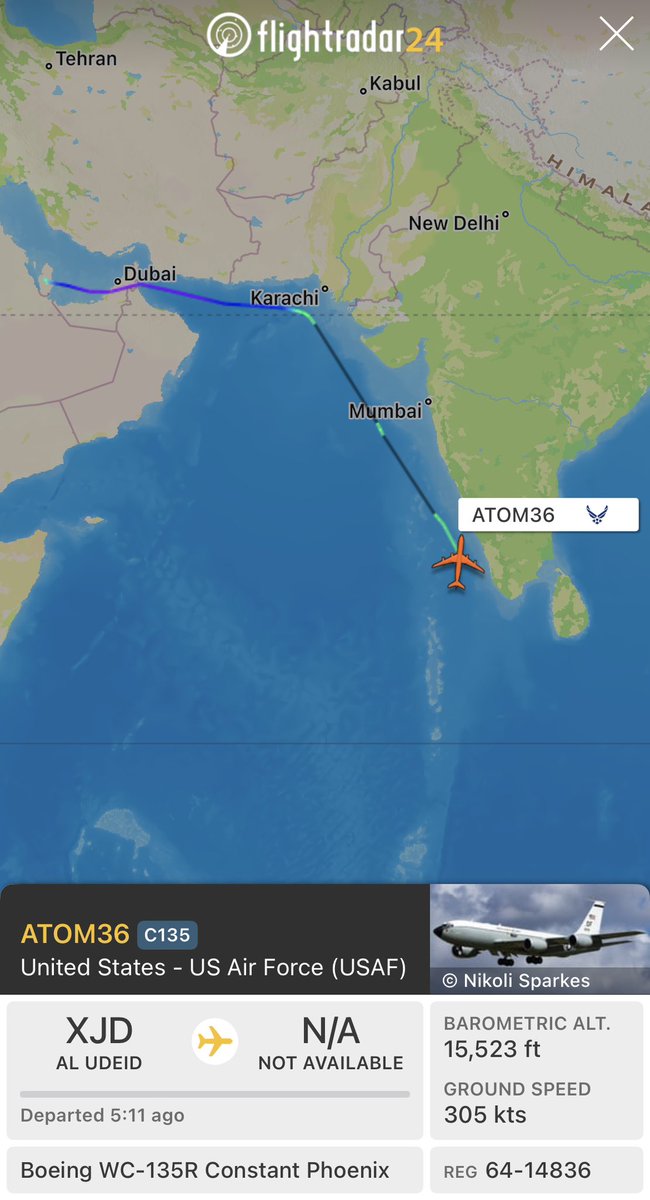SOURCE: IDRW.ORG TEAM

In a noteworthy development, a US WC-135R “nuclear sniffer” aircraft, with the callsign ATOM36, recently conducted a mission along the coasts of both India and Pakistan. This aircraft, officially designated as WC-135R Constant Phoenix, is renowned for its specialized role in detecting signs of nuclear explosions in the atmosphere.
During this mission, the WC-135R Constant Phoenix flew at a relatively low altitude, descending to 7,000 feet (approximately -2,100 meters). The specific reason behind this mission remains undisclosed, leaving room for speculation. It’s important to note that such missions don’t necessarily indicate a nuclear incident but could serve purposes like calibration or routine surveillance.
The WC-135R Constant Phoenix is typically based at Offutt Air Force Base in the United States. However, this aircraft was observed transferring to Qatar via the United Kingdom on October 5th, 2023, before conducting its mission along the Indian and Pakistani coasts.
WC-135R Constant Phoenix: The Nuclear Sniffer Aircraft
The WC-135R Constant Phoenix is an atmospheric collection aircraft developed by Boeing for the US Air Force (USAF). Its primary mission is to conduct air-sampling operations, specifically aimed at supporting the Limited Nuclear Test Ban Treaty of 1963. This international treaty prohibits any country from testing nuclear weapons in the atmosphere, outer space, and underwater.
What sets the WC-135R Constant Phoenix apart is its advanced equipment for atmospheric sampling and collection. This suite of cutting-edge tools includes:
- Whole Air Collection System (WACS): This system allows for the collection of airborne particulates onto filter paper, which can later be analyzed in the event of a nuclear detonation.
- Directional Gamma Sensor System (DGSS): Designed to detect gamma radiation, this system is an essential part of the aircraft’s nuclear detection capabilities.
- Radiation Monitoring and Analysis System (RMAS): As the name suggests, RMAS plays a pivotal role in monitoring and analyzing radiation levels during the aircraft’s missions.
- U1-B Particulate Sampler Assembly: This assembly is responsible for collecting particulate matter from the atmosphere for further analysis.
- Supervisory Control and Data Acquisition (SCADA): SCADA systems are used for real-time monitoring and control during missions.
The WC-135R Constant Phoenix’s unique capabilities make it an indispensable asset in ensuring compliance with nuclear treaties and monitoring for any signs of nuclear activity. Its recent mission along the Indian and Pakistani coasts underscores the importance of such aircraft in maintaining global security and preventing the proliferation of nuclear weapons.
NOTE : Article cannot be reproduced without written permission of idrw.org in any form even for YouTube Videos to avoid Copy right strikes. Websites doing illegal reproductions will get DCMA and Legal Notices.